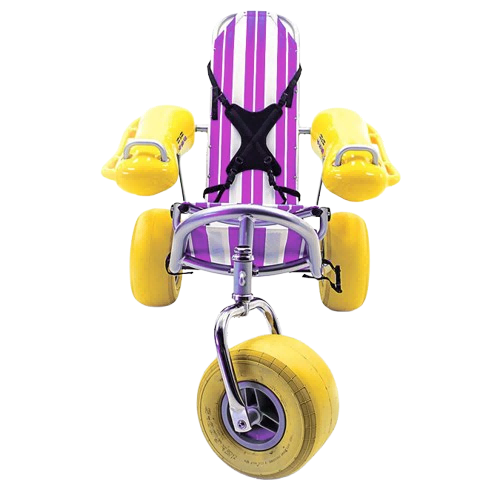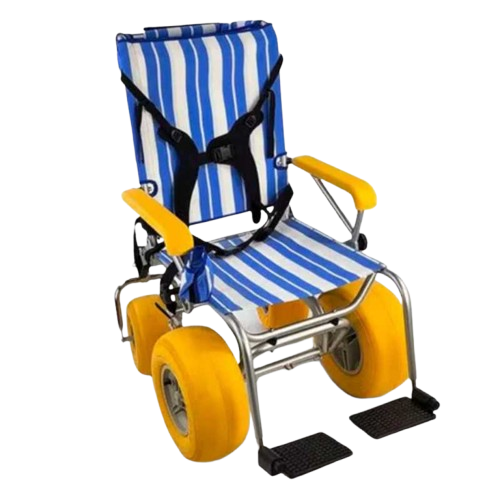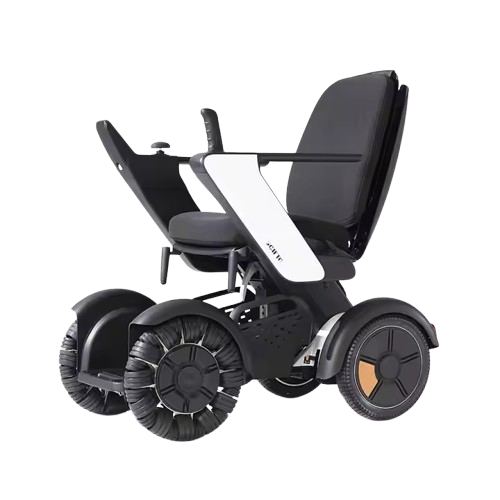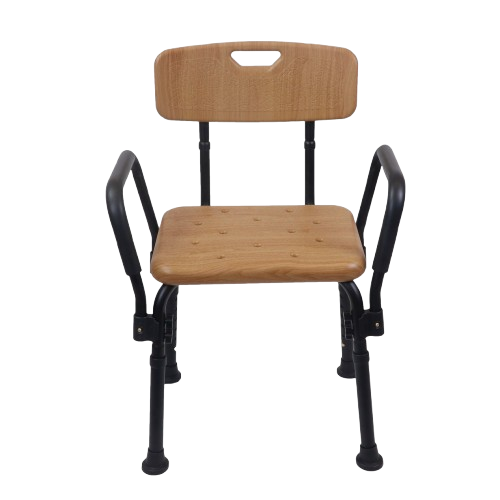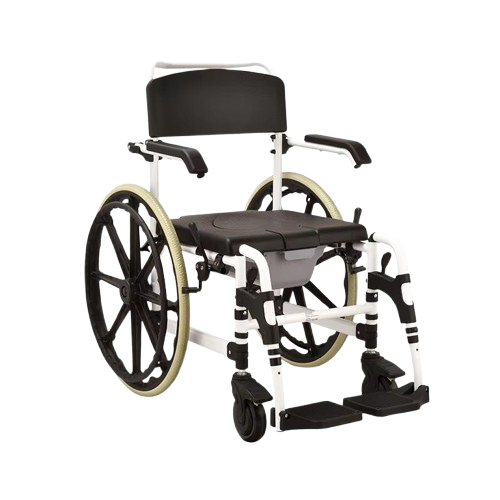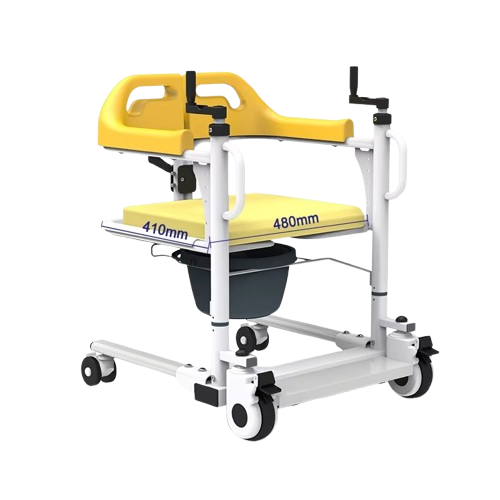For individuals with mobility challenges, accessing the joy of beach experiences requires specialized equipment. Beach wheelchairs with their distinctive large wheels and wide tires make it possible to navigate sandy terrain that would be impossible with standard wheelchairs. However, one of the first decisions many people face is whether to rent or purchase these specialized mobility aids.
This decision isn’t straightforward—it involves considering multiple factors including frequency of use, budget constraints, storage capabilities, and specific needs. In this comprehensive guide, I’ll walk you through the seven key factors that should inform your decision between beach wheelchair rental and purchase, helping you make the choice that best suits your unique situation.
Understanding Beach Wheelchair Basics
Before diving into the rental versus purchase decision, let’s establish a basic understanding of what makes beach wheelchairs different from standard models:
- Specialized Design: Beach wheelchairs feature large wheels and wide tires specifically designed to prevent sinking in soft sand
- Corrosion Resistance: Quality models use materials like 316L stainless steel frames to withstand saltwater exposure
- Stability Features: Many include low center of gravity designs and articulating rear suspension for safety on uneven terrain
- Comfort Elements: Features like adjustable telescopic leg rests enhance comfort during beach outings
- Portability Considerations: Weight and foldability vary significantly between models
With these basics in mind, let’s explore the seven key factors that should guide your decision-making process.
Factor 1: Frequency of Beach Visits
Perhaps the most significant factor in your decision should be how often you actually visit the beach.
For Frequent Beach-Goers:
If you live near the coast or visit beaches more than 5-6 times per year, purchasing may make financial sense. The cost-per-use decreases significantly with each visit, eventually surpassing the rental price point.
Cost Analysis Example:
- Average beach wheelchair rental: $30-50 per day
- Mid-range beach wheelchair purchase: $1,500-2,500
- Break-even point: Approximately 30-50 days of use
For someone visiting beaches weekly during summer months, ownership could pay for itself within 1-2 seasons.
For Occasional Visitors:
If you only visit beaches during annual vacations or a few times per year, renting likely makes more economic sense. This is especially true if you visit different beach locations that might each have unique terrain requirements.
Practical Insight: Many wheelchair accessible beaches now offer improved rental programs with advance reservations and delivery options, making the rental experience much more convenient than in previous years.
Factor 2: Transportation and Storage Capabilities
Beach wheelchairs present unique transportation and storage challenges that standard wheelchairs don’t.
Transportation Considerations:
For Purchase:
- You’ll need a vehicle capable of transporting a beach wheelchair (which can be bulkier than standard wheelchairs)
- Some models require disassembly for transport
- Lightweight models with lightweight construction may be easier to transport but often cost more
For Rental:
- Many rental services now offer delivery to your accommodation
- No need to transport the wheelchair to and from your destination
- Eliminates the need for specialized vehicle accommodations
Storage Requirements:
For Purchase:
- You’ll need adequate storage space at home
- The wheelchair requires protection from elements when not in use
- Some models offer foldable designs but may sacrifice durability
For Rental:
- No storage concerns
- No maintenance or cleaning requirements
- No need to dedicate home space to a specialized piece of equipment
Expert Tip: If storage space is limited but you still want to purchase, look for models specifically designed with compact storage in mind. Some newer designs offer impressive foldability while maintaining structural integrity.
Factor 3: Customization and Specific Needs
Individual needs vary significantly, and this factor can heavily influence the rent-vs-buy decision.
When Specialized Needs Favor Purchase:
- If you require specific postural supports or customized seating
- If you have unique transfer requirements that standard rental chairs don’t accommodate
- If you need specific weight capacity beyond what typical rental chairs offer
- If you require specialized controls or adaptations
When Standard Features Are Sufficient:
- If standard beach wheelchair designs meet your basic mobility needs
- If you don’t require specialized adaptations
- If different beaches might require different wheelchair features
Real User Perspective: “After renting different models at three beaches, I discovered I needed a very specific seat angle and arm configuration for independent transfers. Purchasing allowed me to get exactly what I needed rather than adapting to whatever was available for rent.” – Michael, beach wheelchair user since 2018
Factor 4: Travel Patterns and Destinations
Your typical travel patterns can significantly impact this decision.
For Single-Destination Travelers:
If you typically visit the same beach destination repeatedly:
- Purchasing may make sense as you know the exact terrain requirements
- You can select a model perfectly suited to that specific beach environment
- You’ll become familiar with one piece of equipment
For Multi-Destination Travelers:
If you enjoy exploring different beaches around the country or world:
- Rental provides flexibility to use equipment best suited to each location
- Eliminates international shipping or transportation challenges
- Allows you to experience different models and features
Travel Insight: Many inclusive beach resorts now partner with quality beach wheelchair providers, offering discounted rentals for guests. Some even include complimentary use of beach wheelchairs as part of accessibility packages.
Factor 5: Budget Considerations and Financial Factors
The financial aspect extends beyond the simple rental-vs-purchase price comparison.
Initial Investment vs. Ongoing Costs:
Purchase Considerations:
- Significant upfront investment ($800-5,000 depending on features)
- Potential insurance coverage (check with your provider)
- Maintenance costs over time
- Potential resale value
- Tax deductions in some jurisdictions (consult your tax professional)
Rental Considerations:
- Lower immediate cost ($30-70 per day typically)
- No maintenance responsibility
- No depreciation concerns
- Predictable budgeting for beach trips
Hidden Costs to Consider:
For Purchase:
- Shipping costs (can be substantial for heavy items)
- Assembly fees if required
- Accessories and customizations
- Maintenance supplies
- Storage solutions
For Rental:
- Delivery fees if applicable
- Security deposits
- Insurance waivers
- Reservation fees during peak seasons
Financial Planning Tip: Some manufacturers offer financing options, and certain medical insurance plans may cover part of the cost if the beach wheelchair serves therapeutic purposes. Additionally, some disability organizations offer equipment grants worth exploring.
Factor 6: Maintenance Requirements and Durability
Beach environments are particularly harsh on equipment due to sand, salt, and moisture.
Maintenance Realities for Owners:
- Regular rinsing after each use to remove salt and sand
- Periodic lubrication of moving parts
- Inspection of fasteners and components for corrosion
- Replacement of worn parts
- Proper storage to prevent damage
The Maintenance-Free Rental Advantage:
- No responsibility for long-term care
- No cleaning requirements
- No need for maintenance knowledge or tools
- No concern about parts wearing out
Durability Insight: High-quality beach wheelchairs with 316L stainless steel frames can last 10+ years with proper care, while lower-cost models might show significant corrosion or mechanical issues within 2-3 years of regular use in beach environments.
Factor 7: Flexibility for Changing Needs
Mobility needs and physical conditions can change over time, affecting equipment requirements.
When Changing Needs Favor Rental:
- If the user’s condition is progressive or changing
- If you’re new to beach wheelchairs and still determining optimal features
- If different family members with different needs will use the equipment
- If you want to try various models before committing
When Stability of Needs Favors Purchase:
- If the user’s condition is stable long-term
- If you’ve already identified the optimal features through rental experiences
- If consistent, familiar equipment is important for the user’s comfort and confidence
Adaptability Consideration: Some manufacturers offer modular designs that can be adjusted or upgraded as needs change, providing a middle ground between the flexibility of rental and the consistency of ownership.
Decision Framework: Putting It All Together
To help you make this decision systematically, consider scoring each factor based on your personal situation:
- Frequency of Beach Visits
- 5+ times yearly: Favors purchase
- 1-4 times yearly: Neutral
- Less than once yearly: Favors rental
- Transportation and Storage
- Ample space and suitable vehicle: Favors purchase
- Limited space or transportation challenges: Favors rental
- Customization Needs
- Specific adaptations required: Favors purchase
- Standard features sufficient: Favors rental
- Travel Patterns
- Same destination repeatedly: Favors purchase
- Multiple different destinations: Favors rental
- Budget Considerations
- Available funds for investment: Favors purchase
- Limited budget or preference for pay-as-you-go: Favors rental
- Maintenance Willingness
- Comfortable with maintenance tasks: Favors purchase
- Prefer maintenance-free experience: Favors rental
- Need Stability
- Stable, long-term needs: Favors purchase
- Changing or uncertain needs: Favors rental
After evaluating each factor, you’ll likely see a pattern emerge that points toward either rental or purchase as the more suitable option for your situation.
Hybrid Approaches: The Best of Both Worlds
Some users find that a combination approach offers the best solution:
Rent-Before-You-Buy Strategy
Try renting different models at various beaches before making a purchase decision. This allows you to:
- Experience different designs and features
- Understand what works best for your specific needs
- Make an informed purchase if you decide to buy
Ownership Plus Occasional Rental
Some users purchase a beach wheelchair for their most frequent destination but still rent when traveling to beaches with significantly different terrain. This approach:
- Provides the convenience of ownership where it matters most
- Offers flexibility when traveling to new destinations
- Allows for trying new models as technology evolves
Shared Ownership Models
In some communities, families or organizations share ownership of a beach wheelchair, splitting both the cost and maintenance responsibilities. This can be:
- More economical than individual ownership
- More convenient than repeated rentals
- A way to access higher-quality equipment at a shared cost
Resources for Both Rental and Purchase Options
Whether you decide to rent or buy, here are some valuable resources:
For Rentals:
- Beach Accessibility Directories: Websites like accessiblebeaches.org list wheelchair friendly beaches with rental options
- Tourism Office Inquiries: Many coastal tourism offices maintain lists of beach wheelchair rental services
- Accessibility Apps: Several smartphone applications now feature beach wheelchair rental location finders
- Beach Mobility Services: Specialized services in popular beach destinations often offer delivery and pickup
For Purchase:
- Manufacturer Direct: Companies like DeBug Mobility, Mobi-Chair, and Vipamat sell directly to consumers
- Medical Equipment Providers: Many DME (Durable Medical Equipment) suppliers now carry beach wheelchairs
- Online Marketplaces: Specialized online retailers offer comparison shopping across brands
- Used Equipment Options: Facebook groups and disability equipment exchange websites sometimes offer pre-owned options
Conclusion: Making Your Informed Decision
The choice between renting and purchasing a beach wheelchair ultimately comes down to your unique combination of needs, resources, and preferences. By carefully considering the seven factors we’ve explored, you can make a decision that maximizes beach enjoyment while minimizing unnecessary costs and complications.
Remember that the goal is to find the solution that best enables beach accessibility and enjoyable experiences. Whether that means the convenience of rental or the consistency of ownership will depend on your individual circumstances.
For many users, starting with rentals and potentially transitioning to ownership as beach visits become more frequent represents a sensible pathway. Others may immediately recognize that their specific needs or frequent usage clearly points toward one option over the other.
Whatever you decide, the most important outcome is that you or your loved one can experience the joy, relaxation, and therapeutic benefits of beach environments with the right equipment to make it possible.
Have you had experiences with beach wheelchair rentals or purchases? What factors influenced your decision? Share your insights in the comments to help others navigating this important choice!


